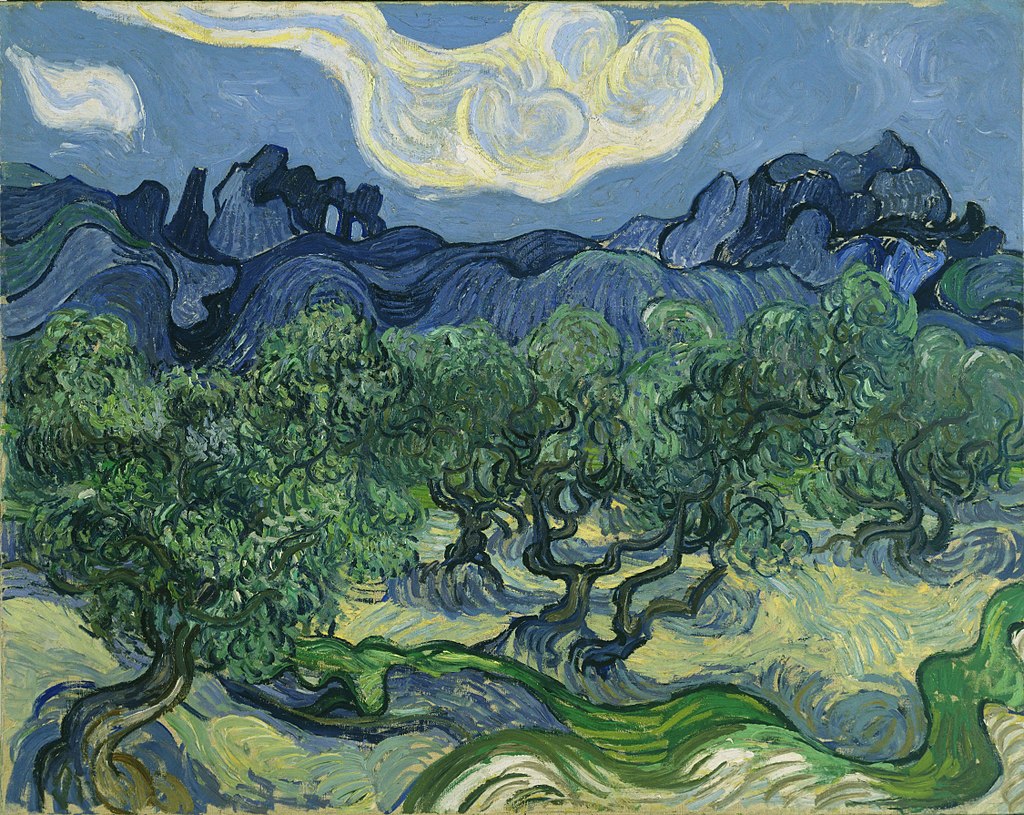
“Olive Trees with the Alpilles in the Background” by Vincent van Gogh depicts green olive trees twisting and swirling as if reflecting the radiating heat from the ground on a hot day in June 1889 in southern France.
The olive grove is capped by the rolling blue hills of the distant Alps, beneath a light-washed sky with bundled clouds engaged in their own twisting dance of nature.
The Chaîne des Alpilles in the background of this painting is a small range of low mountains in Provence, southern France. The landscape of the Alpilles is one of the arid limestone peaks separated by dry valleys.
Vincent van Gogh painted many images of the Alpilles’ landscapes during his time in Saint-Rémy-de-Provence on the north side of the mountains.
Van Gogh voluntarily entered the asylum at Saint-Rémy in the south of France in 1889, and from there he wrote his brother Theo:
“The olive trees with the white cloud and the mountains behind, as well as the rise of the moon and the night effect, are exaggerations from the point of view of the general arrangement; the outlines are accentuated as in some old woodcuts.”
This painting is the daylight partner to complement The Starry Night, the painting Van Gogh was writing about to his brother.
Van Gogh felt that both pictures showed, in complementary ways, his belief, regarding the freedom of the artist to go beyond:
“the photographic and silly perfection of some painters,”
and intensify the experience of color and linear rhythms.
Vincent van Gogh painted at least 15 paintings of olive trees, mostly in Saint-Rémy-de-Provence. He lived at an asylum there from mid-1889 through to mid-1890, painting the gardens and the surroundings of the asylum.
With permission, he ventured outside its walls, to the nearby olive trees, cypress, and wheat fields. The olive tree paintings had special significance for van Gogh.
His Olive Tree paintings represented life, the divine, and the cycle of life, while some of olive tree paintings were his attempt to symbolize his feelings about Christ in Gethsemane.
The Garden of Gethsemane is where Jesus prayed on the night of His betrayal and arrest. Gethsemane was a garden at the foot of the Mount of Olives in Jerusalem.
Today, Gethsemane has magnificent ancient olive trees that date back to hundreds of years ago, still producing olives today.
Van Gogh found respite and relief in interaction with nature. When the series of olive tree paintings were made in 1889, he was ill and emotionally in turmoil, yet the pictures are considered to be among his most beautiful works.
Olive Trees in Provence, France
Olive Trees with the Alpilles in the Background
- Title: Olive Trees with the Alpilles in the Background
- Artist: Vincent van Gogh
- Nationality: Dutch
- Year: June 1889
- Medium: Oil on canvas
- Dimensions Height: 73 cm (28.7 in); Width: 92 cm (36.2 in)
- Movement: post-Impressionist
- Museum: Museum of Modern Art, MOMA, NY
Vincent van Gogh
Vincent Willem van Gogh is among the most famous and influential figures in the history of Western art. Van Gogh was unsuccessful during his lifetime and was considered a madman and a failure.
He created about 2,100 artworks, including around 860 oil paintings, most of them in the last two years of his life.
They were characterized by bold colors and dramatic, impulsive, and expressive brushwork that contributed to the foundations of modern art.
Vincent van Gogh
- Name: Vincent Willem van Gogh
- Born: 1853 – Zundert, Netherlands
- Died: 1890 (aged 37) – Auvers-Sur-Oise, France
- Resting place: Cimetière d’Auvers-Sur-Oise, Auvers-Sur-Oise, France
- Nationality: Dutch
- Movement: Post-Impressionism
- Notable works:
- Starry Night
- Starry Night Over the Rhône
- Sunflowers
- Irises (Getty Museum)
- Self Portrait, dedicated to Paul Gauguin
- Portrait of the Postman Joseph Roulin
- White House at Night
- The Night Café
- Self-Portrait as a Painter
- Self Portrait with Felt Hat
- Green Wheat Field with Cypress
- The Raising of Lazarus
- Self-Portrait Mutilated Ear
- Café Terrace at Night
- Tarascon Stagecoach
- Wheatfield with Crows
- Bedroom in Arles
- Portrait of the Artist’s Mother
- Vase with Red Poppies
- Memory of the Garden at Etten
- Great Peacock Moth
- Farmhouse in Provence
- Agostina Segatori Sitting in the Café du Tambourin
- Fishing Boats on the Beach at Saintes-Maries
- Seascape at Saintes-Maries
- Girl in White
- Young Peasant Woman with Straw Hat Sitting in the Wheat
- Van Gogh’s Chair
- Gauguin’s Chair
- Saint-Rémy – Road with Cypress and Star
- Almond Blossoms
- The Church at Auvers
- The Yellow House
- Portrait of Père Tanguy
- Portrait of Doctor Félix Rey
- Olive Trees with the Alpilles in the Background
A Virtual Tour of the Museum of Modern Art, (MoMA), NY
- “Reflections of Clouds on the Water-Lily Pond” by Claude Monet
- “The Starry Night” by Vincent van Gogh
- “Broadway Boogie Woogie” by Piet Mondrian
- “Le Grand Nu” by Amedeo Modigliani
- “The Sleeping Gypsy” by Henri Rousseau
- “Christina’s World” by Andrew Wyeth
- “La Goulue arriving at the Moulin Rouge” by Henri de Toulouse-Lautrec
- “Gas” by Edward Hopper
- “The Dream” by Henri Rousseau
- “The Moon and the Earth” by Paul Gauguin
Vincent van Gogh’s The Olive Trees
Olive Trees – Painting by Vincent van Gogh – 1889
Vincent van Gogh – Landscapes
~~~
“The best way to know God is to love many things.”
– Vincent van Gogh
~~~
Photo Credit: 1) Vincent van Gogh [Public domain], via Wikimedia Commons; Véronique PAGNIER / CC BY-SA (https://creativecommons.org/licenses/by-sa/3.0)
Popular this Week








 Sponsor your Favorite Page
Sponsor your Favorite Page SEARCH Search for: Search Follow UsJoin – The JOM Membership Program
Sponsor a Masterpiece with YOUR NAME CHOICE for $5
Share this:
- Tweet

